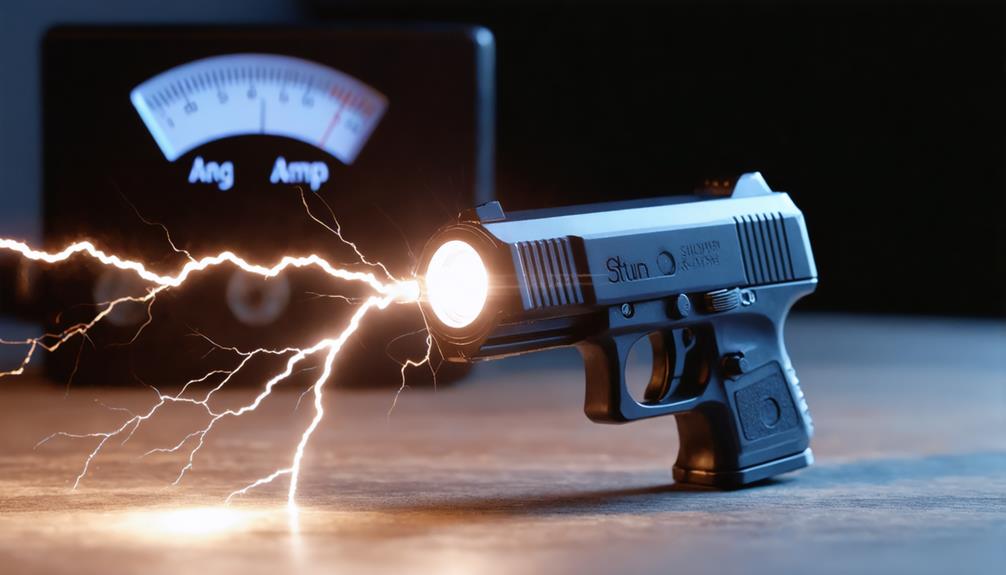
Brainstorm Security Shop

For Orders Over $199

On Any Of Our Products

Details On Refund Page
When you’re considering a stun gun for self-defense, you might wonder how many amps it should have. Typically, amperage ranges from 1 to 5 milliamps, but that number alone doesn’t tell the whole story. You’ll need to think about how this amperage influences effectiveness and safety. After all, it’s not just about stopping an attacker; it’s also about minimizing potential harm. So, what factors should you really consider when choosing the right stun gun for your needs?
When it comes to understanding stun gun basics, you should know that these devices are designed to incapacitate an attacker by delivering a high-voltage electric shock. The stun gun design typically includes two metal prongs that emit electricity when activated. This shock disrupts the body’s normal electrical signals, causing temporary muscle spasms and disorientation.
You’ll find that stun guns come in various shapes and sizes, making them easy to carry and conceal. Popular designs often resemble everyday items like flashlights or cell phones, which can enhance your ability to surprise an assailant.
However, while using a stun gun, you must prioritize electrical safety. Always familiarize yourself with the device’s instructions and ensure it’s properly charged before use. Avoid touching the prongs or using the device in wet conditions, as moisture can increase the risk of unintended shocks or malfunctions.
Voltage and amps play crucial roles in the effectiveness of a stun gun. While amps are essential for delivering an electric shock, voltage impact determines how effectively that shock can incapacitate an assailant. Higher voltage levels increase the potential for penetration through clothing and skin, making the stun gun more effective in real-life situations.
When you consider a stun gun for personal safety, it’s important to understand that both voltage and amps contribute to its overall performance. However, safety concerns arise when dealing with higher voltage. Although a stun gun might produce a high voltage, it’s crucial that the amperage remains low. This is because high amperage can lead to severe injuries or even death.
You need to balance the voltage impact with safety to ensure that the stun gun is effective but also not lethal. Always check the specifications of any stun gun you’re considering, focusing on both voltage and amps, to make sure you’re choosing a device that meets your safety and effectiveness needs. Remember, the goal is to deter an attacker, not to cause lasting harm.
Understanding typical amperage ratings is vital for selecting a safe and effective stun gun. Many people mistakenly believe that higher amperage automatically translates to more stopping power. However, the truth is that amperage safety is more about how the stun gun affects the body than just the numbers on a device.
Most stun guns operate between 1 to 5 milliamps (mA), which is generally considered effective for self-defense while minimizing risk. It’s important to note that the amperage in a stun gun doesn’t directly indicate its effectiveness; instead, it’s how the device interacts with the human body.
Amperage misconceptions can lead to unnecessary fear or overconfidence. High amperage might sound intimidating, but it doesn’t guarantee a safer or more effective device. In fact, a stun gun with a lower amperage can still incapacitate an assailant effectively if used correctly.
When choosing a stun gun, focus on its design, reliability, and personal comfort rather than just the amperage rating. Understanding these typical amperage ratings helps ensure that you’re selecting a stun gun that’s both effective and safe for personal use.
Amperage plays a crucial role in determining a stun gun’s effectiveness, but it’s not the sole factor. While higher amperage can enhance the stun gun’s ability to incapacitate an attacker, other elements come into play that can affect its overall performance. Here are some considerations to keep in mind:
Understanding the amperage impact gives you insight into the effectiveness correlation between amperage and the stun gun’s ability to neutralize threats. However, remember that a stun gun’s effectiveness isn’t solely dependent on amperage alone.
If you combine the right amperage with effective techniques and awareness of your environment, you can maximize your chances of success in a self-defense situation. Always prioritize safety and responsibility when using any self-defense tool.
When it comes to choosing the right stun gun, you need to consider several key factors to ensure you select a model that meets your self-defense needs. Start by evaluating the stun gun features, such as voltage and amperage. A higher voltage doesn’t always mean a more effective device; it’s the amperage that plays a crucial role in incapacitating an attacker. Look for a stun gun with at least 1 million volts and an adequate amp rating.
Next, consider the size and weight. You want a device that’s easy to carry and handle. Compact models can fit in your pocket or purse, making them more accessible in emergencies.
Don’t forget about safety precautions. Choose a stun gun with a safety switch to prevent accidental discharge. Some models also come with built-in flashlights or alarms, adding extra layers of protection.
Lastly, check your local laws regarding stun gun ownership and usage. Ensuring compliance will save you from potential legal issues. By keeping these factors in mind, you can confidently select a stun gun that suits your self-defense requirements.
A stun gun’s safety relies on its design, not just amperage. Many amperage myths suggest it can kill, but in reality, when used properly, stun guns are meant to incapacitate, not to cause fatal harm.
Yes, there are amperage regulations for stun guns that vary by state. You should check local laws to ensure compliance. Understanding these regulations is crucial for your stun gun safety and responsible ownership.
Temperature impacts a stun gun’s performance by altering conductivity and resistance. As temperatures rise, resistance decreases, enhancing voltage output. Conversely, cold conditions increase resistance, potentially diminishing effectiveness. Always consider environmental factors when using your stun gun.
Stun guns can be used on animals, but you must prioritize animal safety. Always ensure proper voltage control to minimize stress and harm, and consult a professional before attempting to use one on an animal.
If your stun gun malfunctions, stop using it immediately. Check the battery and connections, and try basic troubleshooting techniques. If it still doesn’t work, consult the manufacturer’s guidelines or seek professional assistance for repairs.

Brainstorm Security Shop
1867 Caravan Trail
Ste 105
Jacksonville, FL 32216
Call us toll free: (800) 859-5566